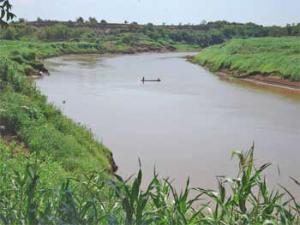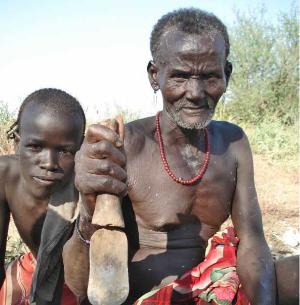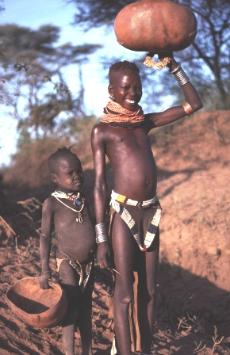
webmaster
© Copyright DEHAI-Eritrea OnLine, 1993-2010
All rights reserved
From: Berhane Habtemariam (Berhane.Habtemariam@gmx.de)
Date: Sat Sep 11 2010 - 17:04:52 EDT
Omo River Dams in Ethiopia: Blessing or Curse?
Yeheyes Wuhib
11 September 2010
During the dry part of the year, when the water table drops, the Nyangatom,
Mursi and other tribes of the area dig deep holes in river beds to water
their cattle and to get drinking water.
"Ethiopia will accomplish the construction at any cost whether donors
continue funds or not."
The giant Gibe III dam, now being built on the Omo River in southwestern
Ethiopia is a boon for some, a problem for others.
Supporters say it will provide electricity for millions of Africans. But
others, like the British-based human rights group
<http://www.survivalinternational.org/> Survival International, say it will
have a devastating effect on an estimated 200,000 people living in the area
of the dam.
The Gibe III will curb the Omo's season floodwaters, which provide water and
silt to enrich local farmland.
The damage caused by the Gibe III dam could be far reaching, according to
Lindsay Duffield campaigner at Survival International.
"The Omo River is the primary source of Kenya's famous Lake Turkana, which
supports the lives of 300,000 people who pasture their cattle on its banks
and fish there. The dam will threaten their survival too," she says.
Survival International is spearheading a campaign to stop the building of
the Ethiopian dam and is urging the African Development Bank and other
institutions to stop funding the project.
The Ethiopian government, on the other hand, says criticism of the
hydroelectric project is fabricated and "far from reality." The National
Security Advisor to the Ethiopian prime minister, Abay Tsehaye, is quoted as
saying the ongoing campaign against the Gibe III dam is an "empty attempt of
some interest groups who do not want to see Ethiopia march towards
development."
Ethiopian Prime Minister Meles Zenawi has repeatedly stressed that no
outside pressure would stop the Ethiopian government from completing the
construction of the dam. "Ethiopia will accomplish the construction at any
cost whether donors continue funds or not," he said.
Upon completion, the $1.7 billon, Gibe III power project will have capacity
to generate up to 1,870 megawatts of electric power, potentially enabling
Ethiopia to export power to neighboring countries.
"The Ethiopian government is entirely unconcerned about the tribes living
in the lower Omo Valley. It is not interested in consulting with them
properly at all," says Duffield. She says in 2009 the local regional
administration for the area surrounding the Gibe III shut down a number of
community associations, making it virtually impossible for the tribes
affected to discuss their views of the dam.
The Ethiopian government further says Gibe III, aside from generating enough
electricity to power the country several times over, will increase the
safety of the downstream peoples by preventing the giant floods that sweep
away livestock and people.
The criticism is "unfounded and unreasonable, [and] aimed to meet self
interest under the pretext of the agenda by putting political and diplomatic
pressure on the country, thereby, to seek money from donors,"says the
national security adviser to Prime Minister Abay Tsehaye.
The Ethiopian government says with the construction of the dam it plans to
boost the current 2,000 megawatts hydropower generation capacity to 8,000.
"It's important to point out that electricity generated by the dam is not
going directly to Ethiopia," Duffield says.
"A great deal of it will actually be taken across the border to Kenya
because the governments have already made agreements. This is not an
electrification project for the benefit of the people who are living in the
area. When all is said and done, the tribes of the Omo Valley who are going
to be affected by this dam are going to get precious little benefit from
it," Duffield explains.
Supporters say the Gibe III and other large hydroelectric dams provide cheap
and efficient "green" energy that can supply electricity to millions.
Duffield says the proponents have failed to explore other options first,
like small scale hydropower dams, wind and solar power.
"A choice has been made to build what will be Africa's tallest dam without
considering the effects it is going to have on the people who live
immediately downstream for it," Duffield says.
Industry associations and lending institutions say they have retooled their
evaluation procedures for large hydro dams and have started to apply new
construction guidelines developed by a discussion forum, the
<http://www.dams.org/> World Commission on Dams.
In 2000, the commission issued a report saying decisions to build large
hydro-electric dams must be guided by indigenous people's free, prior and
informed consent to the project. "[It was] a great move on the part of the
commission at that time, but at this moment not clearly being applied to the
Gibe III project in Ethiopia," says Duffield.
She credits the World Bank for taking more account of environmental and
social issues in its planning and for establishing a complaints procedure
for affected tribal communities. But what the World Bank hasn't done, she
says, is to adequately implement the standard of free, prior and informed
consent, which she says is absolutely vital to tribal people all over the
world. "If they don't have this very basic standard, which the World Bank
should endorse, the results could be very devastating," Duffield warns.
Upon completion, the Gibe III dam will be the second largest hydroelectric
power plant in Africa, also providing electricity to needing neighbor
countries. The dam wall will be 240 meters high, the tallest dam in Africa,
and create a 150-kilometer-long reservoir. Salini Costruttori, an Italian
company, started construction work on the project in 2006. Gibe III is due
to be completed in 2012.
A massive hydroelectric dam threatens the tribes of the Lower Omo River,
Ethiopia
Survival/Serge Tornay
A massive hydroelectric dam threatens the tribes of the Lower Omo River,
Ethiopia
The Kwengu tribe of the Lower Omo river will be threatened by the massive
hydroelectric Gibe lll dam under construction, Ethiopia.
Survival International
The Kwengu tribe of the Lower Omo river will be threatened by the massive
hydroelectric Gibe lll dam under construction, Ethiopia.
Nyangatom girl Kibish, Lower Omo, Ethiopia.
Survival/Serge Tornay
Nyangatom girl with little sister carrying her calabash after watering the
family herd. Kibish, Lower Omo, Ethiopia.



----[This List to be used for Eritrea Related News Only]----
